Quality of the Environment in Japan 1995
ii. Measures of the construction industry
Specific measures that are being carried out by the construction industry are such waste product reduction measures as "reduction, recycling and the proper management of construction materials and construction by-products" (72.4%) and the "reduction and recycling of construction waste" (69.0%). Besides environmental considerations at the development, planning and building methods stages, such as "devise building methods that consider the environment" (60.9 %), and "give utmost consideration to the city environment and natural environment when developing and planning" (50.6%), such methods as "promotion of the use of recycled resources" (51.7%), "promotion of energy conserva-tion" (51.7%) and "reducing the use of, and substituting for, tropical products" (37.9%) are being carried out (Figure 4-5-5).
Fig. 4-5-5 Measures of the Construction Industry
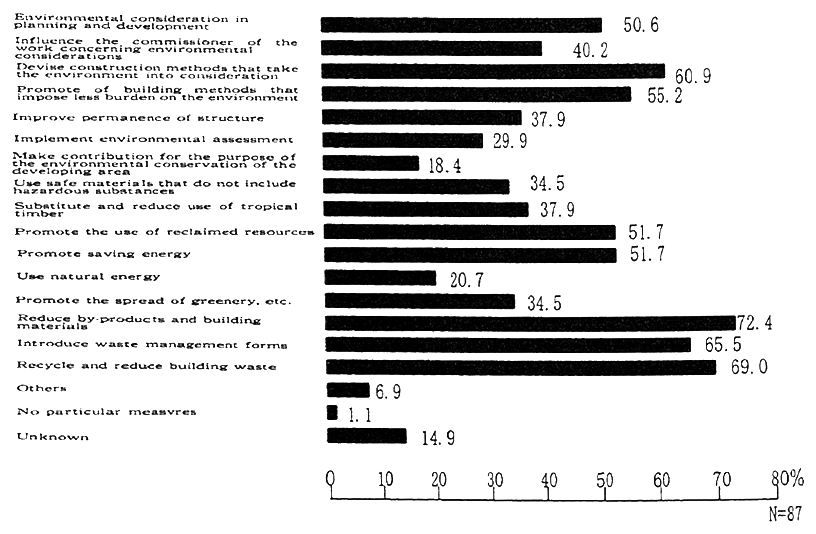
Source Environment Agency
iii. Measures of the distribution, service, transport, communications, financial and insurance industries
First, in the distribution and service industries (82 businesses) in addition to the measures of "using recycled paper (shopping bags, catalogs, pamphlets, receipts, etc.)" (68.3%), "reducing the amount of wrapping (simple wrapping, encouraging people to bring their own shopping bags)" (57.3%), "recovering and recycling manufactured prod-ucts and wrapping (empty cans, empty bottles, trays, milk packages, electric batteries, etc.) (43.9%), businesses are also selling manufactured products that use recycled resources (45.1%), manufactured products that impose a small burden on the environment (37.8%) and manufactur-ed products that can be recycled (34.1%). In the transport and communi-cations businesses (24 businesses) such measures are being carried out as, using low polluting vehicles and devising transport methods (66.7%) and reviewing cooperation for high frequency deliveries and transport (25.0%). In the financial and insurance industries (62 businesses) the measures being carried out are the sale of financial products that contribute to conserving the environment (19.4%) and the implementa-tion of an examination related to environmental conservation with respect to financial or investment matters (3.2%) (Figure 4-5-6).
iv. Measures outside of a company's business which contribute to society outside and inside of the workplace
About 70% of the companies implemented the top three items of "implement energy conservation and resource conservation in the office," implemented by most at, 73.7%. Next were "recycling and thorough separation of waste and old paper, etc." at 69.4%, and "use recycled paper and recycled products" at 67.4%. After these were "participate in regional activities" at 42.5% and "use ecomark products as much as possible" at 38.3%. Further, concerning activities that contribute to society, support environment related foundations and groups (22.7%), implement environment related campaigns (15.1%) and implement environment related lectures, etc. to offer information (11.1 %)are carried out.
The measures of conserving energy, reducing waste and recycling inside businesses are progressing in each business as eco-office creation. The business group measure with the objective of promoting the joint collecting and recycling of old paper in an office building has also started. Further, companies' workplace measures for environmental education of staff and managers is being carried out, and, as can be seen in the measure guidelines for environmental problems of the Japanese Trade Union Confederation, labor union activities related to environ-mental conservation are also starting.
Fig. 4-5-6 Measuren of the Distribution, Service, Transportation, Communications, Financial and Insurance Industries
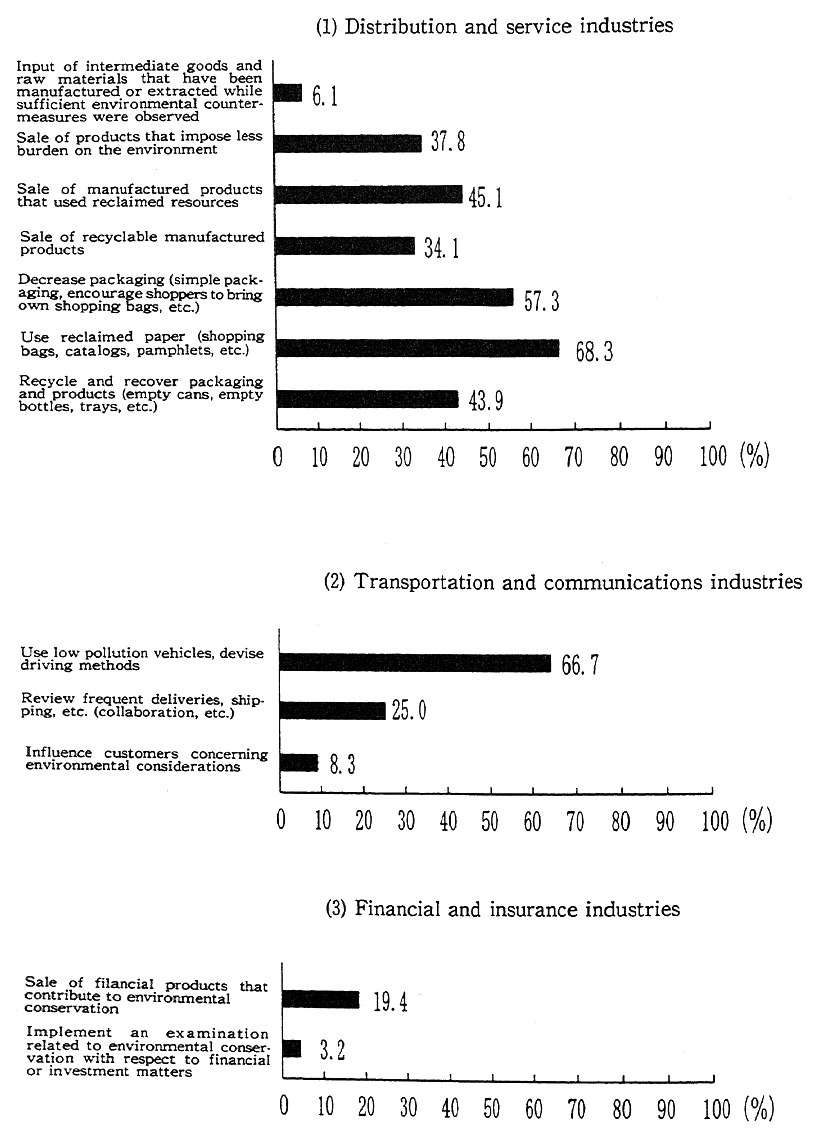
Source: Environment Agency
As seen up to now, in the manufacturing industry, the building industry as well as in the distribution industry, the reduction of the burden on the environment at each stage, such as the extraction of raw materials for manufactured products, manufacturing, distribution, con-sumption and disposal ; the advancement of measures, such as product development that keeps the burden on the environment in view at every stage, the offering of information to consumers and reviewing surplus wrapping ; the use of raw materials that contribute to a reduction of the burden on the environment, such as reclaimed resources, and the use of services that contribute to a reduction of the burden on the environment, such as rationalized distribution services, such as joint delivery and shipping; and, further, cooperation in reducing the burden on the envi-ronment, such as by proper management after a product has been disposed of, are necessary. Further, the "Industry Environmental Vision" of June 1994, that is the opinion report of the Global Environ-ment Subcommittee of the Industrial Structure Council, also sets forth specific and systematic measures for reducing the burden on the envi-ronment by means of many-sided cooperation, such as cooperation between the industries that produce reclaimed resources and the indus-tries that accept and use them, the course of incorporating environmen-tal considerations at each stage of industrial activity in 15 main indus-tries, in order to promote the independent and positive measures of industry towards the environment, from the viewpoint of building a sustainable society while developing a healthy economy that imposes a slight burden on the environment.
Further, each industry is also required to cooperate and collabo-rate in efforts to promote environmental conservation activities, but according to the Environment Agency's Business Action Survey, 12.1% of the total number of 906 businesses carry out a "preliminary check of whether the parties they do business with, or their subsidiaries, have environmental problems." 40.2% of the 87 construction businesses "influ-ence the commissioner of the work regarding environmental considera-tions," and 8.3% of the 24 transport and communications businesses "influence the orderer regarding environmental considerations."
Meanwhile, finance plays an important role in economic activity. Financing work and work related to investing, which are the main work of financial companies, is able to exert an influence related to considera-tion of the environment in companies' investment activities through the supplying of funds to companies. In investing that is subject to inspec-tion, such as financing, there are various kinds of investing related to the environment, including pollution prevention investing, investing in order to improve the environment, such as putting greenery in the area of the business and on the grounds of a business, investing with the object of reducing raw materials and waste that lowers the burden on the production process and, ultimately, causes a reduction in costs. On the contrary, there is investing in production equipment that is con-nected with causing environmental pollution. In Europe and the United States examples have also appeared which call for environmental cleanup responsibility related to the investing, etc., of financial institu-tions. As environmental conservation measures of financial institutions advances, measures such as the establishment of an organization in charge of the environment and the creation of environmental reports can be seen. As for Japan's financial institutions also, consideration of the environmental considerations in business carried out by a company that seeks financing and investment has come to be expected.
Further, concerning the offering of information related to the environment, not a few companies provide information by such means as environmental seminars and citizens' lectures. As for financial insti-tutions also, with respect to small and medium size companies that are apt to have a lack of information concerning the environment, fulfilling the role of an advisor that offers information has come to be expected-According to the survey of measures related to environmental conserva-tion in small and medium size companies in Kanagawa Prefecture, carried out in November 1993, there were many companies that, depend-ing on surveys related to the environment, were developing products and technology that took the environment into consideration and introduced equipment and facilities in order to conserve the environment, as well as carrying out the past pollution countermeasures. But measures for environmental management, such as management plans, objectives, and persons in charge with regard to the environment, have not progressed (Figure 4-5-7)..
(4) Business information disclosure and environmental conservation expenditure
The "Quality of the Environment in Japan 1994"set forth the fact that continuous environmental investment was an important factor in the construction of a sustainable economic society. Even for the environ-mental conservation investment of companies that is an important part of this environmental investing it is very important that it be implement-ed continuously.
Fig. 4-5-7 Measures Related to Environmental Conservation in. Small-and Medium-size Businesses in Kanagawa Prefecture
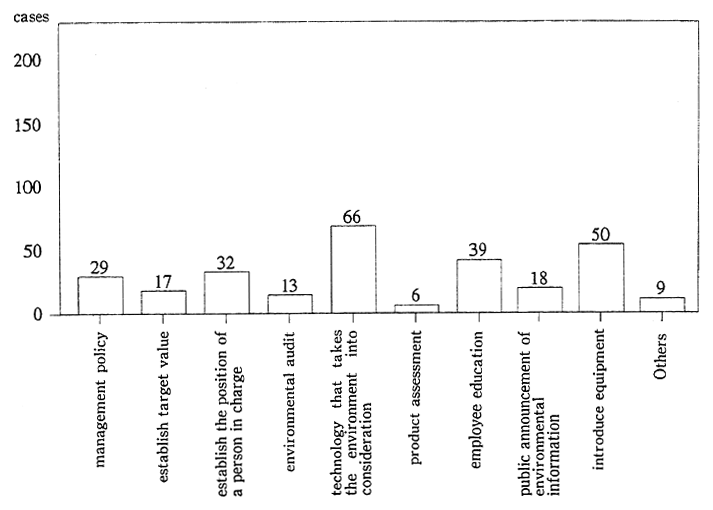
Source: Kanagawa Prefecture
According to the Environment Agency's Business Action Survey of 1994, concerning the burden of cost related to environmental conser-vation, most companies, 67.9%, responded, "would like to bear as much as possible if it does not affect business performance " 8.3% of com-panies responded, "would like to bear it without regard to business performance ; "and 13.1% of companies responded, "think that bearing minimum to pass all present regulations is sufficient." (Figure 4-5-8).
Next, when the situation of the aggregation of expenditures related to the environment is looked at, concerning a company's expend-itures and the amount of investment related to environmental conserva-tion, as for companies that aggregate them distinguished from other expenditures and investment amounts, 10.5% of all companies "distin-guish investment amounts," 7.7% of companies "distinguish expendi-tures," 16.1% of companies "distinguish both expenditures and invest-ment amounts" totaling 34.3% (311 companies), somewhat of an increase from the 29.7% of companies that aggregated investment amounts and expenditures in the previous year. With the aggregation of environmen-tal conservation expenditures, there are the problems of the expenditure subdivision, and of the aggregation rules not being clear, implementing the development of the methodology and the line of thinking of internal-izing environmental costs into the price setting mechanism and account-ing, raised in Chapter 30, "Strengthening the role of business and indus-trial," of Agenda 21, is necessary.
Fig. 4-5-8 Cost Burden Related ot Environmental Cosservation
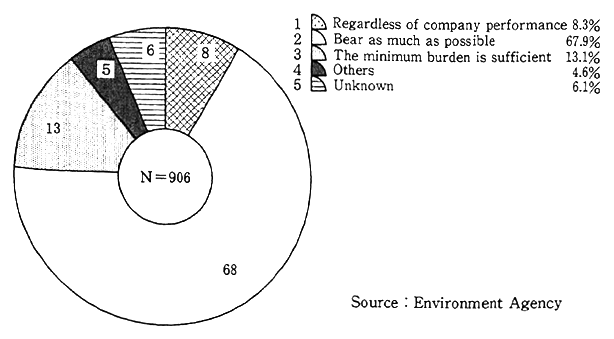
Source: Environment Agency
Concerning the active disclosure of this kind of environmental conservation expenditure and movements to appeal to citizens with environmental measures, most, 42.3% of the total number of replies, were "it would be better to disclose after each company created a common standard." Next, 26.7% replied, "it is mainly acceptable, it would be better if Japanese companies also disclosed," 6.5% replied "in competing with other companies in the same industry it would be better not to disclose," Replies that could be regarded as positive, "it would be better to disclose," amounted to about 70%. Further, the state of companies making public announcements of measures related to the environment is as in Table 4-5-3.
Concerning the measures of companies related to the environ-ment, management plans, though specific targets and action plans are being announced publicly, it can be said that public reporting by means of annual reports, as well as, environmental reports in which the details of the inspections and audits of these measures are recorded, are limited to the measures of some advanced companies. Concerning the indepen-dent, positive measure of disclosure by companies, it has become neces-sary to create a social environment in which independent efforts can be reported, and as a result of disclosure, the measures of a company can be judged to be appropriate by the constituents that surround the company. By means of this the measures of companies related to environmental conservation can be expected to be promoted still more.
Table 4-5-3 Situation of the Public Announcement of Measures
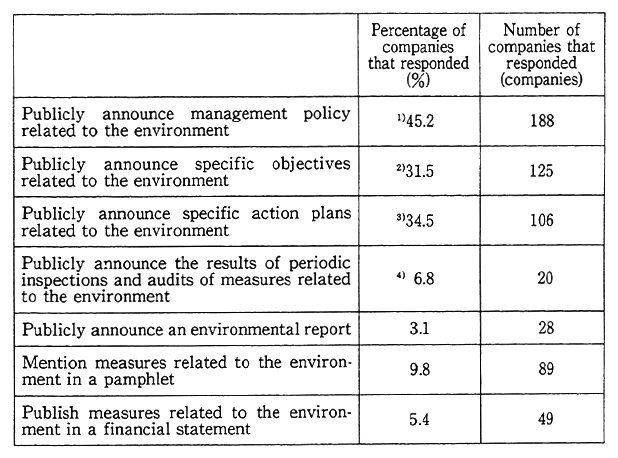
Related to a Company's Environmental Conservation
Note : The percentage of companies responding is the percentage of the 906 com-panies that responded to the questionnaire. Depending on the question, 1) is the percentage on 416 companies that introduce a management policy (includ-ing the answers to the other questions), 2) is the percentage on 397 companies that establish specific objectives (including the answers to the other ques-tions) those which plan to establish them in 1994, 3) is the percentage on 307 companies that draw up a concrete action plan (including the answers to the other questions), 4) is the percentage on 293 companies that implement inspections or audits and those which plan to implement them in 1994.
Source: Environment Agency
4. Cooperation and Collaboration Among Constituencies for Environmental Conservation
As can be seen up to now, in Japan, independent, positive and diverse measures are proceeding in local public bodies and among consumers, as well as private groups and industry. It is necessary that these measures, following the division of roles related to environmental conservation, are able to proceed sufficiently and fairly, moreover, consistently, as society as a whole. But for the actions of each constitu-ency to be further promoted, it has become necessary to implement comprehensive environmental conservation measures while the nation, local public bodies, citizen, as well as private groups, and industry, mutually cooperate and collaborate. The following takes up measures that local public bodies, consumers as well as private groups and indus-try are carrying out while mutually cooperating and collaborating.
(1) The business registration and approval system of local public bodies
In order to promote recycling and measures to reduce the amount of waste among the businesses of the region, a system for the registra-tion and approval of offices and businesses has been started in such local public bodies as Nagoya City, Yokohama City and Toshima Ward. For example, in Takamatsu City, offices within the city that have measures for resource recovery and the reduction of waste are proclaimed "earth friendly offices" and registered. Once a year they submit a resource recovery plan and report. The number of registered businesses was 591 at the end of March 1994.
(2) Groundwork activity
British Groundwork that was started at the beginning of the 1980s establishes a trust in an area, and through the cooperation of residents, companies and government, receives support from the British Department of Environment and carries out work for the creation and conservation of the area's environment. In the company campaign that has been implemented up to now, a wide selection of themes has been selected, such as advice on improving the environments on the grounds of small and medium size businesses, support of environmental conser-vation activities of youth and the physically handicapped, environmen-tal conservation activities at schools with the participation of citizens, youth leadership education on the aspect of the environment, and conservation of historical buildings and views. In Japan, also, in Novem-ber 1994, the Japan Groundwork Association was started, and measures for environmental conservation activity are starting in partnership.
(3) Recycling of packing waste
In the progress of waste recycling measures to reduce the burden on the environment, concerning those necessary among the responsibil-ities and costs related to the measures, in addition to the proper division among businesses, consumers, local public bodies and the nation, it is necessary that the building of an economic and social system progresses wherein inducements are able to be obtained to promote recycling and restraint in the production of waste in each of the stages of product development, manufacture, import, distribution, consumption, dis-charge, recovery and reclamation use.
The importance of measures for the recycling of packing waste is pointed out in the October 1994 report, "Promotion of Reclamation, Reuse and the Reduction of Waste," by the Living Environment Council, Waste Reduction and Reuse Committee of the Ministry of Health and Welfare, and in the July 1994 report, "Future way of Waste Treatment and Recycling System in Japan," by the Industry Structure Council, Waste Treatment Resource Reclamation Subcommittee of the Ministry of International Trade and Industry. In the Basic Environment Plan, concerning packing material, in order to reduce the amount of waste and reduce the burden on the environment, the introduction of a new system of the separate collection of packing waste by cities, towns, and villages and the pickup and reuse by businesses is being studied. The necessary measures are being devised and positive measures for the creation of a framework for the purpose of appropriate recycling are progressing.
Section6. The Basic Environment Plan Linked to a Sustainable Future
1. The Significance of the Basic Environment Plan and the Construction of a Sustainable Future
As we have come to see in every chapter, today's environmental problem, in which we are seeing the limitations of the amount of resources and the environmental capacity over each region, the so-called worldwide limits is a problem requiring consideration that extends back to the problems of culture. In order to continue to protect the environ-ment that is the foundation of human existence, humanity must con-struct a sustainable society that imposes a slight burden on the environ ment (Chapter 1). Further, it is necessary to consider the course Japan should take from an international viewpoint based on the size of the role Japan should play in the world, and the fact that the problem is worldwide in scope (Chapter 2). Further, it is necessary to properly hand over Japan's present environment to later generations based on the present state of involvement in the environment of Japan (Chapter 3).
In this way, while being based on an international viewpoint, it is necessary that all measures to construct a sustainable society and properly hand over to later generations the environment that is the foundation of humanity be promoted to the utmost. However, these measures extend over a wide area and are expanding, furthermore the problems are steadily advancing. On the other hand, the resources that can be invested are limited both in time and money. In this kind of situation, the promotion of highly effective measures, by means of systematically and comprehensively promoting all related measures, including those mentioned in this chapter so far, is necessary.
The Basic Environment Plan, viewed from this perspective, has extremely important significance.
2. Summary of the Basic Environment Plan and the Promotion of Highly Effective Measures
(1) Summary of the Basic Environment Plan and the promotion of highly effective measures
The Basic Environment Plan has stipulated the fundamental principles of comprehensive and long-term policies related to environ-mental conservation, in order to comprehensively and systematically promote policies related to environmental conservation. This plan is Japan's first comprehensive environmental plan decided on a national level by Cabinet decision. By incorporating the thinking on environmen-tal conservation across every area of government, it is able to become a basically important requisite for the construction of a sustainable society from a comprehensive viewpoint. Further, the content of this plan has a new viewpoint and composition. Viewed from the standpoint of the "promotion of highly effective environmental measures," it is significant. We are going to look at the Basic Environment Plan from this viewpoint.
(2) Significance of deciding on the Plan
The Prime Minister, based on article 15 of the Basic Environment Law enacted in November 1993, heard the opinions of the Central Environmental Council and drew up a draft of the Basic Environment Plan that was decided on by the Cabinet. It stipulates the fundamental principles of comprehensive and long-term policies related to the conser-vation of the environment. On 16 December of last year, its first plan was decided on by the Cabinet.
The composition of the entire structure of the Basic Environment Plan stipulated this time can be divided into the four parts of the background and significance of deciding on the plan, the basic direction of environmental policies, the development of policies and the effective implementation of the Plan (Figure 4-6-1).
Part one deals with the significance of deciding on the plan. The purpose of deciding on the plan is that it is something which would look to the middle of the 21st century and, based on the long-term objectives of environmental policy, systematically stipulate the policies of the country until the beginning of the 21st century to clarify the measures that local public bodies, businesses and citizens could expect. The second part stipulates four long-term objectives based on the basic way of thinking of environmental policy that is the basic course of environ-mental policy. Part three takes up about two-thirds of the plan and is the part that stipulates policies. Here, besides mentioning plans that follow the four long-term objectives, policies are stipulated, all together, that would jointly help in the achievement of these objectives. Part four stipulates the framework for implementing the Plan. Specifically, it stipulates a review of the Plan, inspection of the condition of the progress of the Plan, the relationship between financial measures and every kind of national plan.
Part one states the background and course of deciding on the Plan and sets forth a recognition of the trends of the environmental problem from now on, based on an outlook of the economy and society from now on, based on the progress of the environmental problem up to now, and compiles the special characteristics of the environmental problems that should be coped with from now on. This is, primarily, that the environmental problem should not be understood in the context of the separate areas of people's health, living environment and natural environment, but instead should be grasped comprehensively. Secondly, most of today's environmental problems are, for the most part, due to the increase in the burden on the environment due to ordinary daily living activities and business activities. Resolving them requires review-ing lifestyles and the way the economic and social systems should be. For this reason, independent and positive participation, with respect to the environment, by a wide range of constituencies is necessary. Third-ly, today's environmental problem is spreading to a global scale and extending in time to encompass future generations. It is becoming a common problem for humanity. For this reason, preventive measures with a long-term view, in addition to a strengthening of international collaboration are necessary.
In order to cope with the present environmental problem that has these kinds of characteristics, the way of progressing with environmen-tal policies, centered on past regulations only, won't be sufficient. It is necessary that diverse measures that reduce the total society's burden on the environment, from ordinary business activity and living, proceed organically and consistently to improve the entire environment viewed as a whole, and that society as a whole become sustainable and impose a small burden on the environment. In order to be able to promote these kinds of comprehensive, systematic measures, making a summary and comprehensive guideline stating an overview of all of them is an extremely effective method. And that it was agreed to by the persons responsible in every area of government is necessary for their effective promotion. In this sense it can be said that the decision on the Basic Environment Plan has the character of being the foundation for the effective promotion of the environmental measures of a new age.
Fig.4-6-1 Composition of the Basic Environment Plan
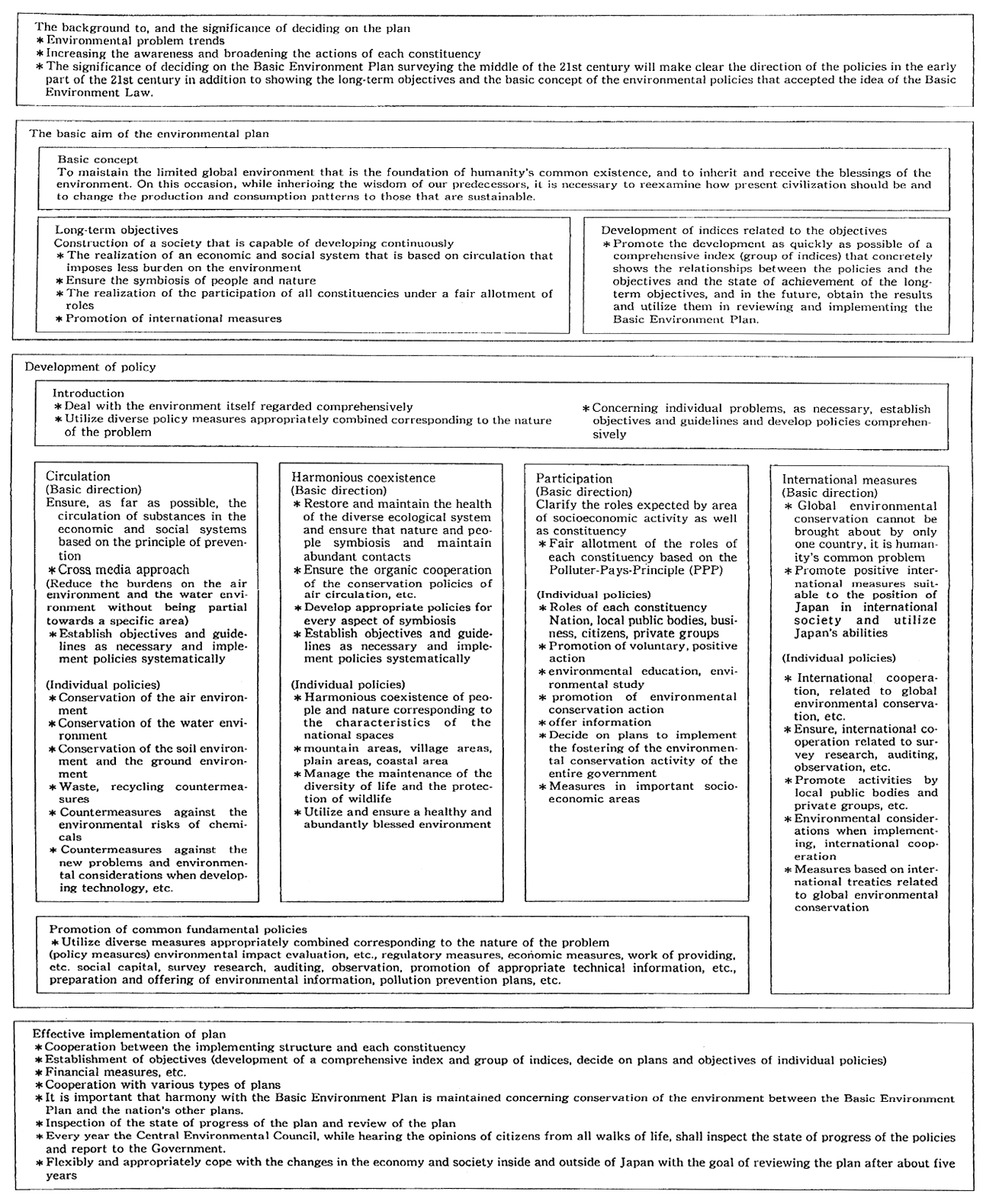
(3) Basic course of environmental policy
In part two, the basic course of environmental policy, after the basic way of thinking is set forth, the four long-term objectives of this plan are stipulated , based on a clarification of the relationship between persons and the environment that is desirable as a long-term objective. Concerning the desired relationship between people and the environ-ment, the following has been stipulated. "The environment is finite and is the life support system of humankind. In the environment, materials circulate between air, water, soil and living creatures. They break down and reassemble in a constant process that is characteristic of nature's circulation of materials. The ecosystem is formed by many delicate balances. In order to conserve a rich, sound environment, it is necessary to maintain both the entire system and each individual, component system in healthy condition. To achieve this, precautionary measures employing scientific knowledge should be applied to avoid serious, irreversible negative impacts on the environment. To harmoniously coexistence with nature, nature's own material circulation should be utilized. In this way, a system incorporating closed material circulation will emerge from everyday socioeconomic activities." The following four long-term objectives are set up based upon the above.
The first is to realize economic and social systems that make circulation their basis, and reduce as far as possible their burdens on the environment in order to prevent burdens on the environment which harms the circulation of natural substances (hereafter referred to as "circulation"). The second is to promote the symbiosis of people and nature to recover and maintain a healthy ecological system by means of maintaining an abundant exchange between people and nature, such as by guaranteeing places and opportunities to come into contact with the diversity of nature, in addition to providing for its wise use, and having an appropriate influence on the environment in the form of protection or maintenance, such as the protective management of wildlife and the restoration of the natural environment, the secondary management of nature, and the conservation of precious, irreplaceable nature, corre-sponding to the special characteristics of the environment that is formed by the mutual workings of man and the diversity of life, as well as soil, water and air (hereafter referred to as "harmonious coexistence"). The third is to realize a society in which people participate in environmental conservation (hereafter referred to as "participation"), independently and positively grappling with problems while cooperating mutually, and collaborating with a fair division of roles corresponding to their respec-tive positions, such as ability to contribute to environmental conserva-tion, benefit received from the environment and burden imposed on the environment, based on the Polluter-Pays-Principle. In order to do this, understanding by all constituencies of the relationship between people and the environment, reforming of senses of values and ways of acting in daily life and work activities, such as by reviewing the wasteful throw-away lifestyle and the incorporation of environmental considera-tions in all socioeconomic activities, is necessary in order to realize the above "circulation" and "harmonious coexistence." The fourth is that Japan should not stop taking the initiative in creating a sustainable society in which Japan itself imposes a slight burden on the environ-ment, but, in addition, should make use of the ability it possesses, such as technology and experience, and, corresponding with the position it occupies in international society, and under international cooperation with every other country with whom it has the global environment in common, should promote international measures (hereafter referred to as "international activities") in order to maintain the global environ-ment in good condition with the positive actions of all constituencies, not just the nation.
By means of this, a long-term objective of the plan is the creation of a sustainable society while providing a healthy economy with a less burden on the environment and maintaining a healthy and abundant environment.
The characteristic of these long-term objectives is the point that in contrast to the past environmental policies that mainly concerned the state of the environment, and set objectives by selecting several items after separating them out into air, water or other medium, or in order to conserve the environment set the objective of the policy in order to prevent a worsening of the environment and the amount of discharge of a pollutant, they are based on the more basic and comprehensive "circulation" and "harmonious coexistence" long-term objectives that call for a review of the way lifestyles and socioeconomic systems should be going back to the way civilization itself should be. That is, as appeared also in Agenda 21 adopted by the UNCED, since they aim at the realization of sustainable development by means of the integration of the environment and the economy, they take all socioeconomic problems as environmental problems, and have made the participation of every constituency of a society, and global partnership, important. What is more, this awareness is the same awareness that this white paper arrived at in Chapter 1 related to civilization and the environ-ment.
The fact that these kinds of long-term environmental policy objectives have been clearly stipulated can be regarded as helping in the effective promotion of the improvement of the environment as a whole and is rationally and consistently linked to the carrying out of the policies directed toward the construction of a sustainable society that imposes a less burden on the environment..
However, it is certain that these long-term objectives, as they are, are qualitative. The Central Environmental Council that examined the Basic Environment Plan carried out an interim compilation of the results of the investigation in July 1994 and when these were widely published and opinions were requested, many questions were collected from the mass media and citizens. The gist of the opinions was expres-sed in questions like, "because the objectives are not concrete and quantitative, isn't it difficult to evaluate the degree to which they have been achieved?" and, "isn't there a danger that, after all, the concrete implementation of the Plan will not proceed?" Based on these kinds of opinions, the Plan, decided on and reported after deliberation in the Central Environmental Council, after recognizing these opinions by saying, "in order to provide for the effective implementation of policies directed toward achieving these objectives, determining an index or group of indices specifically setting forth the achieved states of these objectives, and their relationship to policies, is desirable," since the situation was such that, "inside and outside of Japan investigation and research is actively going on concerning these kind of indices and at the present time their results are insufficient and haven't reached the point at which they can be incorporated into this plan," it said, "for this reason, the development of comprehensive indices related to the long-term objectives of the Basic Environment Plan are rapidly progressing in the government, and, in the future, when the result has been reached, they will be made use of in the implementation, review, etc. of the Basic Environment Plan," and stated that the government should rapidly proceed with the development of indices.
These indices will be a measure for evaluation from the view-point of the wide range of economic and social policies for constructing a sustainable society that imposes a less burden on the environment. Because they are being put into a definite form, they can be expected to greatly contribute to the development of effective environmental mea-sures and to enable the effectiveness of the plan to be heightened still more. Further, also internationally, the development of comprehensive environmental indices, or indices related to sustainable development, is progressing. For example, in the United Nations, development work on indices for sustainable development is progressing. Also the high level gathering, the Commission on Sustainable Development (CSD), that is carrying out the work for the United Nations General Assembly Special Session on Development and the Environment planned for 1997, estab-lished in the United Nations as a follow-up institution to UNCED, declared its support for the promotion of this work. Further, develop-ment of indices that can be used when deciding policy is also progressing in the OECD, having received support in a summit conference of the advanced countries.
When this plan was accepted, preliminary investigations into the development of this kind of index were started. Arrangements have been made to proceed with full-scale development of the index in 1995 with the participation of the related ministries and agencies of the Government.
(4) Development of policy-an introduction
In the development of the policies of part three, various policies were compiled and mentioned following the four long-term objectives mentioned above.
Concerning the objectives and guidelines related to the individual subjects that can be mentioned here, study is being conducted of their respective circumstances and the effect of various measures in their respective frameworks while following the basic direction of the Basic Environment Plan. These were set up as necessity required while considering the mutual relationship of policies and the mutual relation-ship of subjects. Planning the development of policies comprehensively is necessary and, moreover, effective. This plan does not directly stipu-late individual objectives as quantitative objectives related to individual questions concerning measures classified by constituency and amount of work related to individual policies, the burden on the environment and the state of the environment, as described in this plan. These objectives are based on individual laws, or are stipulated in the frameworks of their respective decisions. But, from now on, the plan will decide individ-ual plans and establish specific objectives concerning the necessary areas after planning the effective implementation of policies, in addition to carrying out a review, as necessary and carrying out the study required from a comprehensive viewpoint, following the basic direction of the Basic Environment Plan.
(5) Development of policy-realization of economic and social systems keyed to circulation that imposes a less burden on the environment
The policies for the construction of an economy and society keyed to imposing a less burden on the environment are stipulated here. Here, the burden on the environment is as stated in the Environment Basic Law, "something which is an influence on the environment due to human activity and poses the danger of causing an obstacle to the conservation of the environment." The concept of an economic burden for a long time has, of course, included the act of discharging more than a specific amount of a specified pollutant that is the main target of an environmental policy. But, it is not only that. It is a wider concept that includes extracting resources from the environment, discharging non-hazardous substances into the environment and generating waste that poses a danger of causing a hindrance to the conservation of the environment.
Our civilization, as seen in Chapter 1, rapidly, and ever faster, expanded the use of the environment without sufficient consideration of the ability to continue and, as a result, greatly influenced the environ-ment. On this point it can probably be said that the viewpoint of circulation was not sufficient. The incorporation of this objective, called circulation, into every aspect of life and socioeconomic activity is linked to highly effective environmental conservation. The policies stipulated here should be regarded in this way.
In this plan, first, it is stipulated that the so-called prevention principle way of thinking, and the cross media approach, should be taken as the way of thinking that forms the basis for promoting various policies aiming at circulation. Section 1 also mentioned these, and these are important requisites for the promotion of highly effective environ-mental policies.
In this plan the preventive principle can be stipulated to be, "that there is a fear that immense and/or irreparable burdens may be imposed since scientific certainty on the environment is lacking, therefore, measures, designed with ample scientific knowledge that utilize strict cost/benefit tests should not be delayed." It is stipulated that measures should be promoted based on the thinking that even if scientific certain-ty is not sufficient concerning the certainty of the occurrence of the harm, degree, and the explanation of a mechanism, delaying measures for this reason and inviting an irrecoverable situation should not be done, rather, they should be taken from the viewpoint that measures taken at an early stage and for little cost can produce a great effect. The 15th principle of the Rio Declaration on Environment and Develop-ment adopted by the UNCED has the same viewpoint.
The cross media approach is a measure devised to reduce the burden on the environment by regarding the environmental media of soil, water and air as a whole. Concerning this, the following was stipulated. "Burdens on the atmosphere, water and soil, as impartially as possible, should be reduced. Measures for waste disposal, recycling and measures to reduce the environmental risk of toxic chemicals should be implemented, as should far reaching measures that take into account new problems, arising from advances in technology."
Further, as individual subjects, this plan clarifies the future direction, concerning such environmental considerations, when develop-ing technology as measures for the environmental risk of chemical substances, measures for recycling and waste, the conservation of the air environment, water environment, soil and ground environment, etc. Among them are those which decided the direction of new measures, as this plan, besides stipulating new additional measures based on progress up to now concerning areas that were dealt with before deciding on the plan, such as stipulating the way interim measures should be concerning global warming measures.
One important example concerns the water environment. Added to water quality that has been taken seriously for a long time, the concept "water environment" that includes such things as the water's edge, water life organisms, and water amount, has been made the subject of policy. Among them the function of nature is also observed, and, concerning nature that can also be used in the agricultural and forestry industries, such as by means of the start of a natural forest, measures that promote the management and creation of forests that have the capacity to hold water and the appropriate management of paddy fields that have ground water cultivation capacity, have taken their place. Concerning recycling and waste measures, besides having clarified the preferred procedure of each type of measure as, "first, restrain the production of waste, secondly, reuse of used products, thirdly, carry out recycling and reuse the recovered items as raw materials, and if these are not appropriate from the viewpoint of, such things as the degree of burden on the environment and the technological difficulty, while expecting perfection in environmental conservation measures, promote their use as energy. Finally, concerning the waste produced, carry out proper treatment," it also set forth the policy line concerning the allotment of responsibility and cost, and stipulated the first unified policy line of the government at the Cabinet level. Further, it was stipulated that the environmental risk be evaluated quantitatively as far as possible, and the aim of chemical substance measures was stipulated to be the reduction of it as a whole. Further, also concerning the "predictive approach," it was stipulated that, "From now on, efforts will be made to implement measures to prevent beforehand influences on the environment, using a predictive approach based on the latest scientific knowledge, in the case of the occurrence of the danger of a worsening of the environment due to the burden on the environment due to the activities of persons."
(6) Development of policy-ensuring the symbiosis of man and nature
Concerning the basic direction related to symbiosis, this plan stipulates, "ensure the harmonious coexistence of people and nature, maintain abundant contact between people and nature in various places, such as leisure activities, business activities and daily life, in addition to recovering and supporting the health of various ecological systems in regions through the wise use of the environment in a sustainable form." The way of thinking here is that wise use and contact should be carried out in addition to the conservation of the natural environment corre-sponding to the natural and social characteristics of each region of the nation. That is, that it is necessary to plan to maintain the natural environment through use of a continuous type, upon recognizing that nature that has been affected by human acts is also one way nature should be, and not just to protect excellent nature and primitive nature that has been little affected by human acts.
Policies that concern the Ministry of Agriculture, Forestry and Fisheries, for example, to maintain the natural environment in forests and agricultural areas, to promote environmental conservation type agriculture that reduces chemical fertilizer and agricultural chemicals and maintains the life and habitat of life in agricultural areas, are also positioned from this kind of view.
The incorporation of the viewpoint of environmental conserva-tion into industrial activity, such as the agriculture industry, will not only prevent the destruction of the environment while continuing indus-trial activity, it will, rather, actively enliven environmental conserva-tion, and, in addition to conforming to the concept of the integration of development and the environment, can be said to be something that follows the thinking of highly effective environmental conservation. As seen in Chapter 1, the civilization of humanity up to now has several examples of damage to the environment that is civilization's own foundation due to non-sustainable agriculture. But, rather, by means of environmental conservation type agriculture, there is also the aspect of being able to contribute to the conservation of the environment. Fur-ther, concerning forestry, by means of the progress of the creation, nurture and management of an appropriate forest that corresponds to the characteristics of the region, it is possible to cause the conservation ability of an environment that has a forest to be demonstrated. It is necessary to live together with the environment in this way.
This plan further stipulates that it regards the foundation of a healthy ecological system as internationally important and that the necessity of conserving the diversity of life, about which a treaty has been concluded, is also important. The use of the environment is expand-ing and our civilization today, which also geographically demands resources from the entire earth, has caused the problems of the reduc-tion of types of wildlife, due to the reduction of habitat and life, and the reduction of resources, due to the extraction of resources that exceeds the ability of the environment to recover, and has reached point that ensuring the diversity of life will come to be a big problem. The Plan states that, "biodiversity, as the foundation of humanity's existence and a necessity for a sound ecosystem, must be conserved. It is a basic element which ensures sustainable utilization of biological resources. Every group of each individual species found in every region shall be conserved and the conservation of the entire ecosystem shall be ensur-ed." The healthfulness and continuity of abundant and beneficent nature is sustained because of the diversity of life. The maintenance of the diversity of life is important in order to appropriately conserve the entire ecological system; and protection should not stop simply with the rare species.
Further, the plan stipulates, concerning the ensuring of, and the use of, a healthy and abundantly blessed environment in region building. And it stipulates concerning historical environmental conservation that would bring about a unity with the natural environment, the building of a water's edge that one can become familiar with and the afforestation of cities. Measures, such as the afforestation of cities, also have many points in common with policies to build cities that can withstand disasters. With the appropriate cooperation, it is possible to build still better cities.
(7) Development of policy-realization of the participation of all constituencies with a fair allotment of roles
The following are the measures each constituency should be able to expect and the way government measures should be implemented in order to realize a society that independently and actively participates while mutually collaborating and cooperating based on fair roles for all constituencies from the viewpoint that the incorporation of considera-tion for the environment in all socioeconomic activity is necessary in order to realize "harmonious coexistence" and "circulation."
As the basic way of thinking related to participation, first, the fairness of the allotment of roles will be touched upon in detail. It has been mentioned that the principle that a fair allotment corresponding to respective positions, such as an allotment corresponding to the burden on the environment, an allotment corresponding to the degree of benefit derived from the economy, and an allotment according to the ability to contribute to the conservation of the environment, is necessary. But, particularly, it has been stated that, "recognizing that today all constitu-encies impose a burden on the environment, directly as well as indirect-ly, through their daily lives and ordinary business activities it is impor-tant that each constituency take responsible actions, such as polluters bearing the implementation costs of various measures for environmen-tal conservation based on the Polluter-Pays-Principle of the OECD, and others, that require that the cost of using the environment, such as that due to pollution, be incorporated into prices." The Polluter-Pays-Principle is something for the construction of a sustainable society that imposes a less burden on the environment. The fact that the importance of each constituency acting responsibly (such as by the polluter bearing the implementation cost of various environmental conservation mea-sures based on this principle) has been emphasized is also of great significance from the viewpoint of increasing the effectiveness of envi-ronmental conservation measures while ensuring the efficiency of the economy.
Further, this plan also describes the roles that local public bodies, businesses and private groups are expected to play, in addition to the role that the nation should play. The roles of each constituency were also discussed in the previous section, but they are also important from the viewpoint of increasing the effectiveness of all environmental con-servation measures. And the plan also does not just stipulate items as a matter of principle. It describes the measures that can be expected from each constituency by each socioeconomic area, such as carrying out financing, etc. taking into consideration the state of the implementation of environmental considerations by the business that is subject to finance-ing, etc., the study of policies to enable private environmental groups that carry out activities of great public benefit to obtain corporate status, the creation as early as possible of action plans so that the nation will take the initiative in environmentally friendly actions as a con-summer and a business, independently promoting auditing, etc., while being based on the environmental management procedures that are being investigated by the International Organization for Standardiza-tion (ISO). Further, the first national guidelines on a Cabinet level have also been clarified concerning environmental courses of study and environmental education for the purpose of promoting the independent, Positive actions of each constituency.
Among these, the United States and United Kingdom, etc. are leading the way in initiative action plans of governments as a consumer and a business, but in Japan, also, the related ministries and agencies have come together and started investigatory work that should decide on a plan by this summer. After deciding on this plan, the acquisition of the supplies of each governmental ministry and agency, the maintenance work and the management of government office buildings, etc. can be expected to change to an environmental conservation model in line with the plan.
(8) Development of policy-promotion of common, basic policies related to environmental conservation
In the policy procedures of environmental policies, each of the objectives of circulation, harmonious coexistence, participation and international activities have important things in common. Chapter 4, Section 3 of the Basic Environment Plan stipulates concerning these kind of common basic policies. Here such matters as, "environmental impact assessment (EIA), etc.," "regulatory measures," "economic measures," "environmental infrastructure improvement," "scientific research, monitoring/observation and environmental technology," and "providing and maintaining environmental information" are prescribed.
Concerning environmental impact assessment, etc., it states, "in order to comprehensively conserve the environment, it is essential that precautionary environmental consideration is made in formulation and implementation of policy measures and projects. This concept is widely recognized and firmly established both domestically and internationally. To further environmental considerations such as implementation of environmental impact assessment, the following measures shall be enhanced." It further stipulates, "environmental consideration for gov-eminent policies," "environmental consideration at planning stage of public works," "promoting EIAs for projects," and "promoting system-atic research on EIA." And, concerning the way the environmental impact assessment system, about which citizens' opinions have also tended to be numerous, should be from now on, it stipulated, "based on the result of this research, the Government shall make necessary recon-sideration of the institutional framework of EIA, possibly including future legislation."
Concerning the regulatory method, the following was stipulated: "Regulatory measures can also appropriately ensure that the environ-mental costs are incorporated in the market mechanism. Thus, the current regulatory measures are to be implemented properly, and those measures shall continue to be applied in the future, taking account of characteristics of a particular problem, effectiveness and impact of the measures, and so on."
Concerning economic measures, after pointing out the main fac-tor in the occurrence of today's environmental problems originates in extensive socioeconomic activity, including daily life and ordinary work activity, the Plan further states, "it is pointed out that the social cost of environmental load arising from these activities has not been well understood and the measures have been lagging behind, therefore the cost has not been incorporated in market mechanisms." It clarified the awareness that, "regarding these problems, it is required to appropriate-ly implement regulatory measures, economic measures and others so as to ensure that each member of society acts in an environmentally friendly manner."
Among economic measures, because measures that impose an economic burden require deliberate discussion, and the presentation of the "interim compilation of the Basic Environment Plan study" was difficult to understand, the thinking of the Government was judged to have not been clear. Accordingly, clarification of the writing in the plan ultimately decided on was strived for. That is, it clarified the view that, "economic measures are placing new burdens on those parties conduct-ing activities generating environmental load-burdens which until recently had not been paid before." In addition to that, stipulating, "in order to make a decision on economic measures to be implemented, studies and investigations shall be appropriately promoted as to their effectiveness for environmental conservation, impacts on the national economy and so on, in consideration of the fields to be applied such as controlling carbon dioxide emissions to prevent global warming, mea-sures for urban/household-generated pollution, or reducing waste." Further, concerning economic measures to promote recycling and restraint on the production of waste also, studies, etc. on the utilization of economic measures, such as a deposit refund system and the promo-tion of imposing a treatment fee tax, have been specified.
Concerning the work of providing social capital, "To create a society ensuring sustainable development with reduced environmental load, it is necessary to promote environmental infrastructure improve-ment." It is clearly stated that "project plans should be examined to assess possible environmental impacts, and conservation measures based upon the result must be implemented." Further, to prevent hin-drances to environmental conservation, or, when promoting the work of providing public facilities that contributes to this, it states, "the effec-tiveness of the projects will need to be evaluated." It also specifies the necessity of evaluating the necessary effect in order to ensure that the effect on environmental conservation increases.
Concerning the promotion of appropriate technology and the perfection of supervision, observation, and survey research, it is indis-pensable that they be accurately carried out in order to appropriately decide on policies related to environmental conservation, to explain the mechanism of environmental change and to grasp the state of the environment-various measures in order to promote this have been stipulated.
Concerning the promotion of survey research, that progress would be made in a wide range of social and cultural areas-not just in natural science-and, when necessary, that the related ministries and agencies will carry out unified measures is stated. Further, it illustrated several problems that should be dealt with in the future: the problems of evaluating and explaining environmental risk ; the problems related to the mutual relationship of the environment and the economy, such as the establishment of a unified environment and economic reckoning system; the problems related to the way policy decision making should be to cope with the environmental changes that accompany uncertainty, and it specified the problems of the new viewpoint necessary to compre-hensively increase the effect of environmental policies.
Further, concerning the compilation and presentation of environ-mental information, since it is necessary to provide for its systematic compilation and use in order to promote environmental conservation measures scientifically and comprehensively, it stipulates concerning basic compilation in the country, such as the systematic compilation of environmental information, the presentation to the citizens of environ-mental information and the provision of a system to explain the environ-ment. The necessary compilation and presentation of information, also, is a necessary factor in order to increase the effect of environmental conservation measures and is also described in Section 4.
Concerning comprehensive measures in areas with a conspicuous degree of pollution, "regional pollution abatement programs shall be formulated for designated areas where the effects of pollution are currently severe in coordination with other policies" is stipulated.
Concerning environmental conservation countermeasures, "the government shall enact measures to prevent pollution-related health damage and outbreaks of victims. Additionally, for victims it shall promote prompt and fair protection measures as well as ensuring their health based on Polluter-Pays-Principle" is stipulated.
(9) Promotion of international measures
Since Japan's measures towards global environmental problems were incorporated in the policies aimed at "circulation,"introduced above, in this chapter, avoiding overlap with those, is stipulated the line of measures centering on policies with respect to other countries, such as those by Japan towards-foreign countries and international society.
Here, first, after setting forth the basic position that global environmental conservation "is a problem common to all of humanity and it cannot be resolved by one country acting alone. Japan must contribute to this international effort in a manner suitable to its position in the international community." It stipulates concerning measures based on international treaties related to global environmental conser-vation, environmental considerations in the implementation of interna-tional cooperation, promotion of activities by local public bodies or private groups, the ensuring of international cooperation related to survey research, supervision and observation and promoting interna-tional cooperation concerning global environmental conservation.
Specifically, it stipulates concerning the obtaining and nurturing of private, local public body and national personnel as the staff of the domestic base that will accomplish an international role, the flexible operation grant aid and loan aid, the strengthening and expansion of the continuance of Japan's environmental ODA, accomplishing the role of a leader in the Asian and the Pacific area, active participation in the Global Environmental Facility (GEF) that is the central mechanism to supply funds for global environmental conservation, guidelines so that Japan can positively participate in and contribute to the creation of mechanisms and discussion concerning the necessary problems that require international collaboration, such as policies to enable free trade and environmental conservation to mutually support each other. Fur-ther, it stipulates concerning the importance of environmental consider-ations in the overseas activity of businesses, the implementation of international cooperation by local public bodies and the creation of an international network for survey research.
International activities are important for the effective implemen-tation of global environmental countermeasures. Further, in these coun-termeasures there are essential factors in common with countermea-sures against domestic environmental problems. Consequently, it is important to increase the effect of countermeasures concerning both global environmental problems and domestic environmental problems by means of carrying out domestic as well as international activities collaboratively, or as one body.
(10) Effective implementation of the plan
Part four of the Basic Environment Plan stipulates concerning a review of the state of progress of the plan and various collaborations with the plan, such as financing measures, the setting of objectives, the collaboration of each constituency with the implementing constituency, in order to concretely and effectively implement this plan that is the general plan.
The setting of objectives and the necessity of the measures of each constituency are described in the plan up to part three, but these are stipulated again from the viewpoint of effectively implementing the plan. Further, since it is necessary, in order to effectively promote the implementation of various policies that are stipulated in the plan, concerning financial measures, it is stipulated, "make efforts to provide necessary financial and other assistance for expenditures" Further, because collaboration with other plans is necessary in order to construct the sustainable society that imposes a slight burden on the environment that is the objective of the Basic Environment Plan, concerning collabo-ration with various other plans, after stipulating the principle that, "The Basic Environment Plan is the nation's basic plan for environmental conservation. It is therefore essential that between the Plan and other national plans, harmony with the Basic Environment Plan should be maintained relating to environmental conservation," it stipulates, "Other national plans which are exclusively aiming at environmental conservation shall be formulated and promoted in accordance with the principle directions of the Basic Environment Plan. As for other national plans which include provisions on environmental conservation, these are to be compatible with the principle directions of the Basic Environment Plan related to environmental conservation, so harmoni-ous coordination shall be ensured with the Plan."
Further, finally, concerning the "follow-up of progress and review of the plan" for the effective implementation of the plan, in addition to stipulating that, "to ensure the steady implementation of the Basic Environment Plan, the Central Environment Council will follow-up the progress of measures under the plan every year, hearing the opinions of the public and each sector of society, and, where necessary, report to the Government on future policy directions," and, so that it would be a more effective plan corresponding to changes in the situation, stipulated that, "The Plan shall be reviewed, responding flexibly and appropriately to the changes of economy and society in Japan and abroad. The review will be made in around five years after the Cabinet decision on the Plan."
As concrete a measure related to this the Basic Environment Plan a promotion headquarters was established on 16 December of last year on the same day as the Cabinet decision on the Basic Environment Plan in the Environment Agency that is mainly assigned the task of compre-hensively promoting administration related to environmental conserva-tion. Further, cooperation within the government is essential to the coordinated implementation of extensive related policies, and because coordinated implementation is necessary in order to investigate counter-measures against problems that various ministries and agencies have in common, in order to investigate countermeasures against problems that various ministries and agencies have in common, at the end of December of last year the "Ministry and Agency Liaison Committee Related to the Promotion of the Basic Environment Plan," chaired by the Direotor-General of the Environment Agency's Planning and Coordination Bureau and participated in by the executive staff of the bureau head rank of 22 related ministries and agencies, was established. The creation of plans to take the initiative as a government are making progress in this committee.
Further, in order for the various ministries and agencies to collaborate to implement effective policies as one body, the costs necessary for policy investigation is appropriated in the Environment Agency's 1995 budget draft, and, by means of movement in the various ministries and agencies, as necessary, the collaboration of various ministries and agencies is provided for from the policy drafting stage on.
Further, also concerning the adjustment of the budgets of various ministries and agencies through the policy estimates of environmental conservation costs that have been carried out up to now, the consolida-tion of the costs have been changed to follow along with the Basic Environment Plan and a program was made that will help in managing the promotion of this plan. Further, the amount of the cost of environ-mental conservation in the 1995 budget draft is about 2.6 trillion yen. It is 1.6% of the total national budget.
This plan sets forth great expectations that comprehensive pol-icies related to environmental conservation will be decided on also with respect to local public bodies that are central in the implementation of many environmental conservation countermeasures. Already, seven urban and rural prefectures and designated cities had enacted basic regulations concerning the environment as of November of last year. Comprehensive environmental plans have been decided upon by six groups. Further, as support measures to realize the Basic Environment Plan in local areas, subsidies have been appropriated in the 1995 Envi-ronment Agency budget for initiatives among the independent opera-tions newly being carried out by local public bodies that need to realize the four long-term objectives of the Basic Environment Plan.
3. Towards a Sustainable Future
Today environmental problems have spread to a global scale. Moreover, our mass production, mass consumption and mass disposal type of economic and social systems and lifestyles are continuing up to this day. In addition to this, when the problems of the conservation of the environment of the developing areas and the situation of the acceler-ating increase of the population are looked at, there is the danger that the global environment that is the foundation of human existence will be harmed during the next century if they continue in this way. In order to avoid this kind of situation, we must construct a sustainable society and acquire a great environmental conservation effect at an early period by devising the necessary countermeasures comprehensively and systemat-ically.
The Basic Environment Plan, as seen above, has the character of being something that has stipulated the way policy measures should be, the roles of each constituency and the general principles of policies to promote more highly effective environmental policies that have aimed at the construction of a sustainable society that conserves the environ-ment. In addition to cooperating with all related constituencies and following the direction of measures across a wide range of areas set forth in the plan, the government as one body, must promote counter-measures that serve to heighten the environmental conservation effect. By these means we must construct a sustainable society before the danger of harming the global environment that is the foundation of human existence becomes an actuality.
By means of them, we will be able to change our lives from lives that pursue only material abundance that does not take notice of the limited global environment that is the foundation of the existence that humanity possesses in common to lives that heighten true abundance and are supported by the great blessings of the global environment
Example of view simulation in the redevelopment of a shopping street (Musashi-Sakai Station north exit) (National Institute for Environmental Studies)

Children listening to the environment and filling in a "sound map", examples of "sound map"

Chapter5. The Current State of the Environment
As mentioned also in the previous chapter, today's environmental problems can be said to be shifting from the former condition centered on the destruction of nature and severe pollution with a specific comparatively small number of causes, to the condition of an increasingly serious environmental problem which extends to a global scale due to ordinary economic and social activity that has grown to a large scale in a mass production, mass consumption and mass disposal type of society. The amount discharged and the concentration in the air of sulfur dioxide peaked in the first half of the decade from 1965 to 1975 and afterwards decreased conspicuously. But on the other hand, conditions have appeared like the air pollution due to nitrogen dioxide and the suspended particulate matter originating in automobile traffic, etc., the increase in the amount of carbon dioxide emitted that became the cause of global warming that accompanied the increase in the consumption of fossil fuel, the water pollution of closed water areas originating in household effluent and the increase in waste.
In the Basic Environment Plan decided by the Cabinet in Decem-ber 1994 "sound material cycle" and "harmonious coexistence" were mentioned as long-term objectives. The objective, "sound material cycle," is to realize economic and social systems that have circulation as their keynotes and reduce as far as possible the load on the environment in order to prevent a worsening of the environment due to harm to the circulation of natural substances. The objective, "harmonious coexistence," is to ensure the coexistence of people and nature and to recover and maintain a healthy ecological system by means of the maintenance of an abundant exchange between people and nature in addition to carrying out the wise use of and exerting an appropriate influence on the environmnt.
This chapter, while being based on this viewpoint of this Basic Environment Plan, looks specifically at the problem mainly related to "sound material cycle" from Section 1 to Section 4 and the problem mainly related to "harmonious coexistence" in Section 5 and Section 6.
Further, the Basic Environment Plan also mentions the long-term objective, "participation," in order to realize "sound material cycle" and "harmonious coexistence."
Further, Section 10 looks at the relationship between the environ-ment and the Great Hanshin-Awaji Earthquake.
Section1. Current State of Atmosphere
1. Current Atmospheric Conditions
Concerning the state of air pollution in Japan, recently the good situation regarding sulfur dioxide and carbon monoxide has been continuing. As for nitrogen dioxide and suspended particulate matter, the state of compling with the environmental quality standards centered in the large metropolitan areas has continued at being on a low level of attainment, and as for photochemical oxidants, there is a severe pollu-tion condition in the entire country.
(1) Nitrogen oxides
Nitrogen oxides (NOx), such as nitrogen monoxide (NO) and nitrogen dioxide (NO2) occur mainly accompanying the combustion of fossil fuels. As the source of their occurrence there are stationary sources, such as the boilers of factories and moving sources, such as automobiles. Nitrogen oxides is not just the causal substance of acid deposition and photochemical air pollution, it is known that nitrogen dioxide in high concentrations exerts a harmful influence on the respira-tory organs.
In Japan among nitrogen oxides, concerning nitrogen dioxide, the objective of countermeasures is the establishment of an environmental quality standard (the standard that is desirable to be maintained to protect the health of people) of a "one hour value of the one day average value in a zone from 0.04 ppm to 0.06 ppm or less." In 1993 the measurement of the concentration of nitrogen dioxide has been carried out at 1,419 general air pollution monitoring stations (hereafter referred to as "general stations") set up in order to grasp the situation of general air pollution and 346 roadside air pollution monitoring stations (here-after referred to as "roadside stations") set up along roads in order to grasp the situation in the vicinity of roads.
Since 1970 (as for roadside stations since 1971), as for the average yearly value of the concentration of nitrogen dioxide in the continuous measurement stations, since 1979 a decreasing trend can be seen, but since 1986 it has increased and in 1993 also it has been moving at a high level (Figure 5-1-1). Further, a detailed explanation of the recent trend is in Part II, Chapter 7, Section 1. When the state of achieving the national environmental quality standards is looked at, the number of stations at which the concentration of nitrogen dioxide did not exceed the environmental quality standards of 0.06 ppm that is at the upper limit of the zone of the environmental quality standards, was, at general stations 63 stations out of 1,419 stations (4.4%) (in 1992, 37 stations out of 1,406 stations (2.6%)) and 114 roadside stations out of 346 stations (32.9%) (in 1992, 96 roadside stations out of 336 stations (28.6%)), an increase in each case.
Fig. 5-1-1 Trends in Average Annual Value for No2(average at stations maintaining continuous observations)
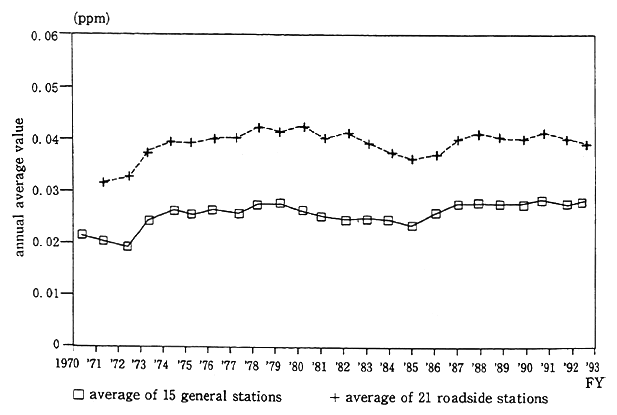
Source Environment Agency
The number of stations that have not achieved the environmental quality standards in the three areas, Osaka City, Yokohama City and the Tokyo metropolitan special district, that have introduced systems of regulating the total amount of NOx concerning stationary sources, such as factories, in accordance with the Air Pollution Control Law, has increased at both general stations and roadside stations at general stations, of 118 stations, 47 stations (39.8%) in 1992 and of 118 stations, 35 stations (29.7%) in 1993; and, at roadside stations, of 73 stations, 65 stations (89.0%) in 1992 and of 72 stations, 53 stations (73.6%) in 1993. Further, as for the number of stations of the Automotive NOx Pollution Control Law's special districts (Tokyo metropolitan specified area, Osaka and Hyogo specified area) that did not achieve the environmental quality standards, in each of the stations there was also an increase: at general stations, in 1992 of 313 stations, 36 stations (11.5%) in 1993, of 315 stations, 62 stations (19.7%) ; at roadside stations, in 1992 of 152 stations, 82 stations (53.9%), in 1993 of 155 stations, 100 stations (64.5%).
In this way the state of achievement of the environmental quality standards, centering on the metropolitan areas, has remained at low level and the promotion of still stronger countermeasures is necessary. With respect to stationary sources, such as factories, regulations were carried out according to standards for the regulation of the total amount, by factories in highly polluted areas, and emission standards by scale and type of facility. Further, concerning automobiles that are moving sources, in addition to the progress of the strengthening of the exhaust regulations on automobile, in the special areas under the Automotive NOx Pollution Control Law, automobile-type regulations are being carried out to promote a change to automobile-types that have fewer exhaust gases of nitrogen oxides and various measures based on Programs for Reductions in Areawide Total Pollutant Load Control. Further, various measures to assist the promotion of the diffusion of low pollution vehicles are being devised. And, taking the opportunity of the expansion of the import of petroleum products, concerning automobile fuel, in addition to planning to ensure the quality necessary for the maintenance of the air quality, the Draft Law Amending Air Pollution Control Law has been submitted to the 132nd Diet, the content of which requires appropriate use of automobiles, and planning is being done for its appropriate enforcement once it is enacted.
Concerning various foreign countries, from 1985 to the decade of the 1990s, in the main cities of advanced countries, such as Dunkerque (France), Amsterdam, Lisbon and London, the situation of air pollution due to nitrogen oxides has become worse and pollution prevention countermeasures are not sufficiently advancing (Figure 5-1-2).
(2) Suspended particulate matter
Suspended particulate matter (SPM) means particles with a diameter of 10 fハm or less among the substances in the form of a particle (floating dust, aerosols, etc.) that are floating in the air. SPM stays in the air for a long time because it is minute. And it exerts an influence on the respiratory organs as it settles in a high concentration in the windpipe and lungs. In suspended particulate matter there are primary particles that are released into the air directly from a source and there are secondarily formed particles which are substances that have been released into the air in the form of a gas, such as nitrogen oxides and sulfur oxides, and change into substances with a particle form in the air. Their sources are those due to the actions of people, such as the black smoke included in the exhaust of diesel vehicles and the particles of soot emitted from factories and naturally occurring sources, such as the whirling up of soil.
Fig. 5-1-2 Trends in NO2 Pollution in Major Cities in Developed Countries
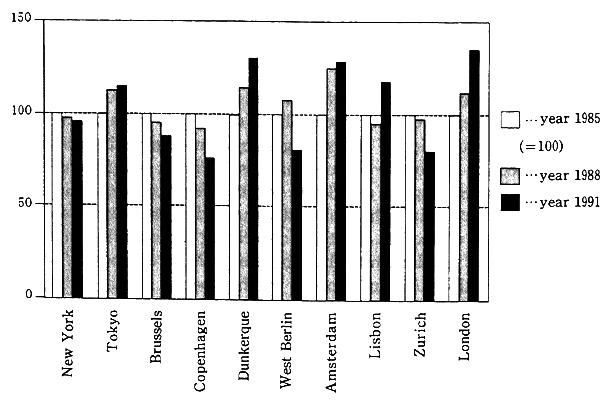
Source : OECD Environmental DATA 1993
In Japan, the environmental quality standard for suspended particulate matter is set at "hourly value of the daily average value is less than 0.10 mg/m3 and the hourly value is less than 0.20 mg/m3." And, regulation of the emission of black smoke from automobiles and of dust and particles of soot from businesses and factories is being carried out directed towards the achievement of the environmental quality standards.
The average annual value of the concentration of suspended particulate matter at the continuous measuring stations since FY 1974 (since FY 1975 at roadside stations) has been steady for several years (Figure 5-1-3). Further, Part II, Chapter 7, Section 1 describes recent trends in detail. The rate of achievement of the environmental quality standards, as for general stations the 57.6% (811 stations of 1,408 stations) of FY 1992 was 58.3% (839 stations of 1,440 stations), and for roadside stations the 33.5% (61 stations of 182 stations) of FY 1992 was 40.5% (77 stations of 190 stations) an increase in each of the stations, but, as before, they are moving at a low level and the state of achieve-ment in the Kanto area was especially poor. Further, the fall in the rate of achieving the environmental quality standards in Kyushu, Chugoku and Shikoku areas is striking. This is assumed to be due to the influence of yellow sand.
Fig. 5-1-3 Changes in the Annual Average Value of Suspended Particulate Matter (average of stations that observe continuously)
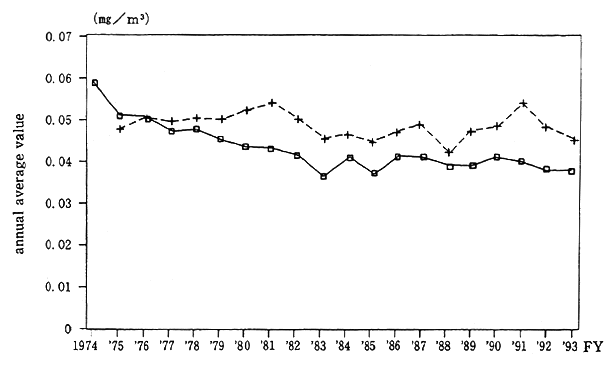
Concerning suspended particulate matter, research is progressing on the development of methods of predicting pollution and on an explanation of the mechanism of pollution, and comprehensive policies are being studied.
Among suspended particulate matter, minute particles of diesel exhaust (DEP) have especially attracted attention from the point of view of their influence on health because there is anxiety about the relationship between them and the occurrence of cancer, bronchial asthma and hay fever and, at present, research and investigation is progressing.
The Environment Agency, as a DEP countermeasure up to now, has regulated automobile black smoke emission from individual vehicle. Regulation of the entire amount of the emission of suspended particu-late matter, in addition to black smoke, started in 1993. Further, with respect to the long-term objective set forth in the report of the Central Council for Environmental Pollution Control in December 1988, techni-cal evaluation has been carried out to achieve it as soon as possible. Further, study of measures to comprehensively reduce particulate matter discharged by diesel vehicles is being conducted.
Further, with the passage of the Law amending the Air Pollution Contral Law submitted to the 132nd Diet, the necessary measures are being devised to set the approved limits related to the properties of fuel for the purpose of ensuring the quality of automobile fuel that is necessary for the conservation of the air quality.
Among the particulate substances, such as the dust and soot that are scattered in the air following from the accumulation, sorting and crushing of things, particles that are comparatively large and settle easily are called dust fall. Concerning the situation in 1993, the annual average at 16 measuring points where long-term continuous measuring is carried out was 4.1 tons/km2 /month (in 1992, 3.5 tons/km2/month).
The studded tire problem started with their rapid diffusion in snowy and cold areas because of their excellent steering qualities, controllability and convenience on frozen road surfaces. Beginning from the start of the decade that began with 1975 it became a big social problem, not just because of the soiling of laundry and clothes and the discomfort caused by the dust, but also because of anxiety about influ-ence on people's health. At present the manufacture and sale of studded tires have been suspended, the designation of areas where their use is prohibited under the "Studded Tires Regulation Law" is also progress-ing and a conspicuous improvement in the amount of falling dust related to studded tires is being shown.
(3) Sulfur dioxide
Sulfur dioxide (SO2) occurs from the combustion of coal and petroleum that contains sulfur. Besides being known as the substance that is the cause of pollution diseases, such as Yokkaichi asthma, it is also the substance that is the cause of acid deposition.
In Japan, concerning sulfur dioxide, an environmental quality standard of "hourly value of the daily average value is 0.04 ppm or less and the hourly value is 0.1 ppm or less" was established. Measurement was conducted in 1993 at roadside stations (87 stations) and general stations (1,610 stations).
The annual average of the concentration of sulfur dioxide at the stations that have monitored continuously since 1965 (for roadside stations since 1973) has been continuously decreasing with a peak in 1967 (Figure 5-1-4). Further, Part II, Chapter 7, Section 1 describes the details concerning the recent trends. Moreover, as for the rate of achieving the environmental quality standards, at general stations, the 99.6% (not achieved at six stations) of 1992 was 99.8% (not achieved at three stations), and at roadside stations, the 98.7% of 1992 (not achieved at one station) was 100% (achieved at all stations).
Fig. 5-1-4 Changes in the Annual Average Value of Sulfur Dioxide (average of stations that observe continuously)
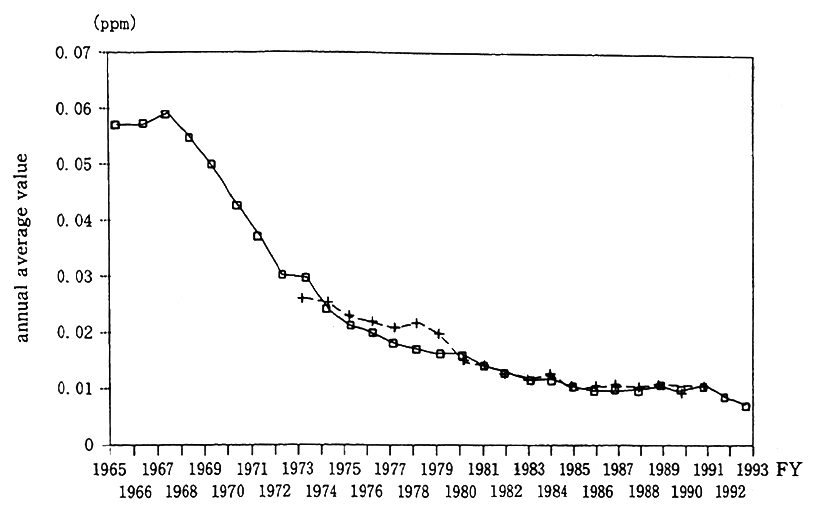
As for air pollution due to sulfur dioxide, because of the rapid worsening due to the mass consumption of fossil fuel in the high growth period, environmental quality standards were first established in February 1969. Various countermeasures, such as the regulation of the total amount by factory in 24 areas throughout the country, regulation of the sulfur in fuel and regulation by facility that generates soot and smoke were devised. Further, businesses also accepted this kind of regulation and expedited positive countermeasures, such as the installation of equipment to desulfurize emitted smoke, the desulfurization of heavy oil and the import of low sulfur crude oil. As a result of this, the concentration of sulfur dioxide in the air, when stations that have been monitoring for a long time are looked at, shows the conspicuous improvement of a decrease yearly from a peak of 0.59 ppm in 1967 to 0.008 ppm in 1993.
When various foreign countries are looked at, in the OECD countries there has been a widespread improvement, but in Beijing, Mexico City and Seoul it has become a still more serious problem. According to the global monitoring system, about two thirds of the world's urban population live in cities which exceed the regulated value for the concentration of SO2 in the environment set by the WHO (Figure 5-1-5).
Fig. 5-1-5 Air Pollution (SO2) in Major Cities No. of days exceeding 150fハ/m3
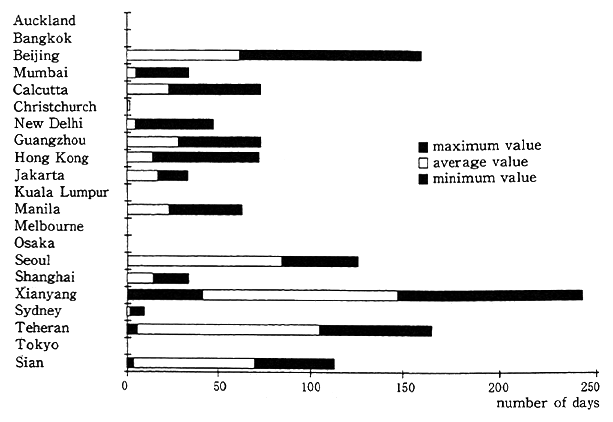
Reference : Global Environment Monitoring System (GEMS), UNEP and WHO 1988
Source : ESCAP "State of Urbanization in Asia and the Pacific 1993"
(4) Carbon monoxide
Carbon monoxide (CO) in the air occurs due to the incomplete combustion of fuel. The source is, mainly, automobiles. Besides exerting an influence on people's health, such as by the carbon monoxide uniting with hemoglobin in the blood and hindering the oxygen carrying func-tion, it is known to lengthen the life of methane gas that has a green-house effect
Concerning carbon monoxide, in addition to having an environ-mental quality standard set in February 1970 at the "hourly value of the daily average value is 10 ppm or less, and the hourly value of the average value of eight hours is 20 ppm or less," the regulation of automobile exhaust is being carried out.
The annual average value of the concentration of carbon monox-ide in the continuously monitoring stations since 1971 has improved from 1965. Recently, it is moving at a low level (Figure 5-1-6). Further, Part II, Chapter 7, Section 1 explains the recent trends in detail. Further, the situation of achieving the environmental quality standards is that all stations achieved it in 1991 and again in 1992.
Fig. 5-1-6 Trends in the Annual Average Value of Nitrogen Monoxide (average of stations that observe continutusly)
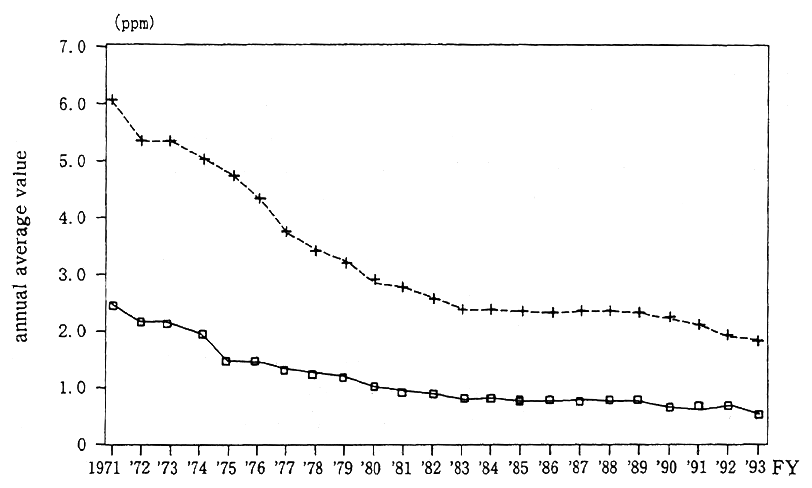
Source: Environment Agency
(5) Photochemical oxidants and non-methane hydrocarbons
Photochemical oxidants are substances that have a strong oxidiz-ing power, such as ozone, that are secondarily formed from the photo-chemical reaction that is caused when the primary polluting substances, which are, mainly, the nitrogen oxides (NOx) and hydrocarbons (HCs), which are emitted from automobiles and factories, are hit by the rays of the sun. Photochemical oxidants are the causes of, so-called, photochem-ical smog. Its influence on the respiratory organs and the mucous membrane in high concentrations is known. An influence on plants, such as agricultural products, also has been reported. Further, it has been said that ozone has a vastly greater greenhouse effect even than carbon dioxide.
In May 1973 the environmental quality standard of "hourly value of 0.06 ppm or less" was established for photochemical oxidants. When the hourly value of photochemical oxidants is 0.12 ppm or more, and, when it is deemed that the condition will continue judging from the atmospheric conditions, the governors of prefectures officially announce a warning and, in addition to rapidly making it widely known to citizens, factories and businesses through the news and educational institutions, call for cooperation concerning voluntary restrictions on driving automobiles or reducing the amount of soot and smoke emitted.
The total number of days when a photochemical oxidant warning was officially announced in 1994 went from the 71 days of 1993 to 175 days. The number of persons that reported harm that can be thought to have been from photochemical atmospheric pollution in 1994 greatly increased from the 93 persons in 1993 to 564 persons. The official warning announcements were particularly concentrated in the Tokyo metropolitan area and the Kinki area (Figure 5-1-7).
Concerning non-methane hydrocarbons that is one of the sub-stances that causes photochemical oxidants, concentration guidelines (average value of the three hours from 6 a.m. to 9 a.m. is 0.20 ppmC - 0.31 ppmC) have been established in order to prevent the occurrence of photochemical smog. The annual average value in the morning from 6 a.m. to 9 a.m. at the continuously monitoring stations since 1978 (at roadside stations since 1977) was 0.49 ppmC in 1992 and 0.46 ppmC in 1993 at six general stations and, at nine roadside stations, 0.46 ppmC in 1992 and 0.43 ppmC in 1993. Since non-methane hydrocarbons, besides being exhausted from automobiles, are also emitted from businesses and painting and printing workplaces that use solvents that contain hydrocarbons, automobile exhaust gas regulations and guidelines to restrain emissions from workplaces are being carried out. Concerning photo-chemical oxidants, besides this, in addition to the progress of investiga-tion and research related to the mechanism of pollution, the preparation of a wide-area monitoring system is progressing.